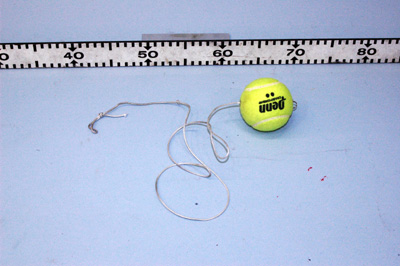|
Size: 1940
Comment:
|
Size: 2135
Comment: converted to 1.6 markup
|
| Deletions are marked like this. | Additions are marked like this. |
| Line 2: | Line 2: |
| ||<:30%>[:PiraScheme#Mechanics: Table of Mechanics Demonstration]||<:30%>[:MEEquipmentList: List of Mechanics Equipment & Supplies]||<:30%>[:Demonstrations:Lecture Demonstrations]|| | ||<:30%>[[PiraScheme#Mechanics| Table of Mechanics Demonstration]]||<:30%>[[MEEquipmentList| List of Mechanics Equipment & Supplies]]||<:30%>[[Demonstrations|Lecture Demonstrations]]|| |
| Line 7: | Line 7: |
| Motion in Two Dimensions, [:MotionIn2D#CentralForces: 1D50. Central Forces] | Motion in Two Dimensions, [[MotionIn2D#CentralForces| 1D50. Central Forces]] |
| Line 10: | Line 10: |
| * '''Cabinet:''' [:MechanicsCabinet:Mechanic (ME)] * '''Bay:''' [:MechanicsCabinetBayA2:(A2)] |
* '''Cabinet:''' [[MechanicsCabinet|Mechanic (ME)]] * '''Bay:''' [[MechanicsCabinetBayA2|(A2)]] |
| Line 14: | Line 14: |
| attachment:Ball02-400.jpg | {{attachment:Ball03-400.jpg}} |
| Line 18: | Line 18: |
| A ball tied to a sting is whirled around in a vertical circle by hand. | A tennis ball tied to a sting is whirled around in a vertical circle by hand. |
| Line 22: | Line 22: |
| ||Ball w/Attached String||ME, Bay A2, Shelf #1|| || | ||Tennis Ball w/Attached String (2)||ME, Bay A2, Shelf #1|| || ||<:-3>Also can be found with in room tact cabinet|| |
| Line 26: | Line 26: |
| * If using the brass ball, be carefull not to smack it on anything as the ball is hollow and dents easily. | * Please use the Tennis Ball ones only! The brass and wood balls, are for hand-held pendulums and can be dented if smacked around. |
| Line 32: | Line 32: |
| 1. Swing the ball into a circular, vertical trajectory. | 1. Swing the ball into a circular trajectory. |
| Line 40: | Line 40: |
| When the ball is swung it is given a momentum. The ball is unable to travel in a straight line, however. The string puts a tension on the ball causing it to arc upward. In other words, the ball is put into a circular trajectory with the centripetal force being provided by the tension in the string which is proportional to the tangential speed of the ball. | When swinging the ball, which gives it momentum, the ball is unable to travel in a straight line. The string puts a tension on the ball causing it to arc around. In other words, the ball is put into a circular trajectory due to the centripetal force being provided by the tension in the string which is proportional to the tangential speed of the ball. To prove the is a central force to the audience, just simply let go of the string. The ball will then travel tangent to the circular trajectory it was on. |
| Line 42: | Line 42: |
| ||attachment:Ball01-250.jpg||attachment:Ball03-250.jpg|| | |
| Line 45: | Line 44: |
| * [https://www.youtube.com/user/LectureDemostrations/videos?view=1 Lecture Demonstration's Youtube Channel] | * [[https://www.youtube.com/user/LectureDemostrations/videos?view=1|Lecture Demonstration's Youtube Channel]] |
| Line 49: | Line 49: |
| * [https://en.wikipedia.org/wiki/Central_force Central Forces - Wikipedia] * [https://en.wikipedia.org/wiki/Centripetal_force Centripetal Force - Wikipedia] |
* [[https://en.wikipedia.org/wiki/Central_force|Central Forces - Wikipedia]] * [[https://en.wikipedia.org/wiki/Centripetal_force|Centripetal Force - Wikipedia]] |
| Line 53: | Line 53: |
| [:Instructional:Home] | [[Instructional|Home]] |
Ball on a String, 1D50.10
Topic and Concept:
Motion in Two Dimensions, 1D50. Central Forces
Location:
Cabinet: Mechanic (ME)
Bay: (A2)
Shelf: #1

Abstract:
A tennis ball tied to a sting is whirled around in a vertical circle by hand.
Equipment |
Location |
ID Number |
|
|
|
Tennis Ball w/Attached String (2) |
ME, Bay A2, Shelf #1 |
|
Also can be found with in room tact cabinet |
||
Important Setup Notes:
- Please use the Tennis Ball ones only! The brass and wood balls, are for hand-held pendulums and can be dented if smacked around.
Setup and Procedure:
- Hold the string in hand securely.
- Swing the ball into a circular trajectory.
Cautions, Warnings, or Safety Concerns:
- N/A
Discussion:
When swinging the ball, which gives it momentum, the ball is unable to travel in a straight line. The string puts a tension on the ball causing it to arc around. In other words, the ball is put into a circular trajectory due to the centripetal force being provided by the tension in the string which is proportional to the tangential speed of the ball. To prove the is a central force to the audience, just simply let go of the string. The ball will then travel tangent to the circular trajectory it was on.
Videos:
References: